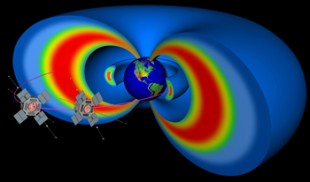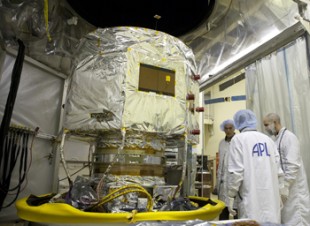Rice physicist Anthony Chan prepares for launch of satellites to Earth’s Van Allen Belts
Living with a star can be a challenge, especially as Earthlings extend their reach into space. A Rice University scientist is contributing to an effort to make life more comfortable for both the people and satellites sent out there, and provide valuable research for those who remain planet-bound.
Two Radiation Belt Storm Probes (RBSP) scheduled for launch from Cape Canaveral, Fla., Aug. 23 will monitor space weather, from the normal eddies of particles that flow through what was once thought of as a void, to the sun’s raging plasma blasts that endanger astronauts, orbiting electronics and even the power distribution grid on Earth’s surface.
The probes will do so from elongated orbits that take them into the heart of the Van Allen Belts, doughnut-shaped regions of high-energy particles encircling Earth. The two NASA spacecraft will travel through constantly changing magnetic fields that trap the high-energy particles but also keep the majority of the harsh radiation of the sun at bay. They’ll back each other up by gathering data on events from different perspectives to give researchers a clearer picture than ever of how solar storms affect the belts.
“These two spacecraft have an unprecedented number of instruments, spanning fields and particles over exceptionally wide ranges,” said Anthony Chan, a Rice professor of physics and astronomy and part of the Energetic Particle, Composition and Thermal Plasma Suite (ECT), which operates one of the instrument sets. “We think we’re finally going to be able to answer some basic questions about the physics of the Van Allen Belts, questions that have been around for over 50 years.”

Twin Radiation Belt Storm Probes will explore high-energy particles that become trapped in Earth's protective Van Allen Belts. The data they return will help Earth-bound scientists, including Rice University physicist Anthony Chan, predict solar storms. (Credit: JHU/APL)
Chan said it is particularly satisfying that Rice is part of a project that promises to solve long-standing mysteries of the Van Allen Belts – and not only because Rice emeritus professor John Freeman was a student of James Van Allen himself. “There’s a very strong theory and simulation group at Rice in space plasma physics,” he said. “The most famous space physics model developed here, the Rice Convection Model, operates in a similar region of space to the Van Allan Belts, but with generally lower-energy particles.”
Chan said the outer radiation belts contain energy in the million-electron-volt range. “We’re especially interested in the electrons, which in those energies are relativistic. They travel close to the speed of light and are much more energetic than anything else out there,” he said.
His task will be to use data gathered from the probes to verify and refine his group’s theories and simulations. “We want to understand the dynamic variability of the outer belt and eventually be able to predict it to the point where it could be useful for spacecraft operators and designers,” he said. “That is one of the practical consequences of this research.”

Engineers at the Johns Hopkins University Applied Physics Laboratory, prepare to place Radiation Belt Storm Probe spacecraft "B" in a thermal-vacuum chamber, where they can make sure the propulsion system will stand up to the range of hot, cold and airless conditions RBSP will face in outer space. The probe is one of two set for launch this month to help predict space weather. (Credit: JHU/APL)
High-energy particles come primarily from the sun, which bombards Earth through coronal mass ejections (CME) that are expected to become more frequent as the sun approaches its “solar max” in 2013, and from coronal holes that appear during less-active periods.
“Most of what we call magnetic storms are driven by solar-wind events,” Chan said. “Some are CMEs, which tend to produce the most violent storms. But another type is caused by high-speed streams in the solar wind that originate in coronal holes. In certain wavelengths, we see dark patches on the sun, usually near the poles. But they sometimes creep down, especially approaching solar minimum.
“These holes have low density but very fast streaming solar wind,” he said, “and can cause some of the largest increases in relativistic electrons.” The particles can overwhelm sensitive electronic instruments like those aboard the location-finding GPS satellites that dot the skies and frequently spend time in the harsh environment of the Van Allen Belts.
“Usually spacecraft avoid these regions, or they switch off equipment when they pass through because it disrupts their operation,” Chan said. “Radiation degrades the instruments’ lifetimes, but the RBSP satellites are designed to fly through these regions and last a number of years.”
The twin satellites will allow researchers to gather the most accurate data yet from energetic events in the Van Allen Belts. They will sweep within 400 miles of Earth and out through the belts, which range from about 8,000 to 40,000 miles. Because researchers can see events triggered by solar activity coming (particularly with the STEREO and Hinode satellites standing guard), they’ll know where and when to look.
Chan said he hopes the probes’ sophisticated instruments will lead to some surprises. “Because electrons are all identical, it’s hard to know where they’re coming from. Nevertheless, we think the majority of them are coming from the sun,” he said.
“There was an interesting theory a while back that some of these relativistic electrons were coming from Jupiter,” Chan said. “There are times – and it’s not as crazy as it sounds – when Jupiter is magnetically connected to Earth. We’re sometimes on the same interplanetary magnetic field lines, and Jupiter is a strong source; it makes lots of radio waves and energetic electrons.
“We see some small peaks about when we expect to see Earth and Jupiter magnetically connected. It’s a great idea and interesting to think about, but it’s probably very weak,” he said. “If it turns out to be much stronger than expected, it would be really interesting.
“The most interesting results scientists get are the ones we don’t expect,” Chan said. “We design the missions looking for certain things and try to allow enough data collection in regions that haven’t been explored to look for something new. And you always hope you’ll find something new.”



Leave a Reply